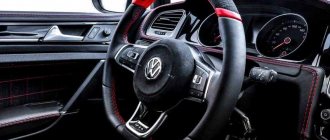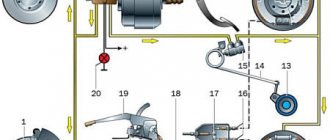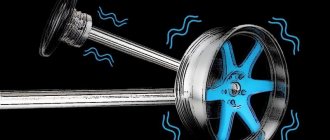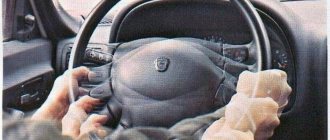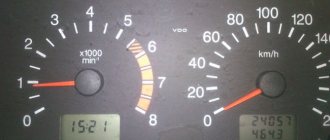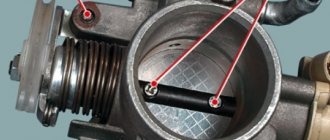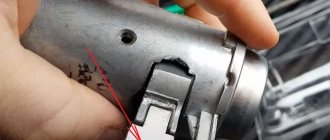The braking system is one of the main mechanisms in a car, responsible for reducing speed and stopping the vehicle. If a car does not go anywhere with a faulty engine, then if there is a problem with the brakes, movement becomes dangerous not only for the driver and passengers, but also for other road users. In this article we will look at the possible reasons for the brakes beating, which indicates some kind of malfunction.
The brake pedal hits when braking - these are extraneous vibrations going to the pedal at the moment of braking. There is a directly proportional relationship between pedal pushes and speed, that is, the higher the speed, the more intense the “response” to the pedal will be. If the speed is over one hundred kilometers per hour, with heavy braking, vibrations can also transfer to the steering wheel and car body.
Why does the steering wheel shake? 7 Main Causes of Steering Wheel Vibration
Care and attention to the technical condition of the car is our direct responsibility. And it doesn’t matter how we feel about it, whether it’s a “workhorse” for us, a means of transportation or a luxury item. First of all, its serviceability is our safety.
And one of the reasons to pay serious attention to your car is the vibration of the steering wheel when driving, or, as experienced drivers say, the beating of the steering wheel. It is expressed in completely different ways and at different speeds, for some at 30 km/h, and for others at 70 km/h. It doesn't really matter. What matters is the fact that there is something wrong with the mechanical part of the car. Let's look together at the seven main causes of this vibration and how to eliminate them. And I’ll tell you about another interesting reason, which is rare, at the end.
How is a malfunction diagnosed?
To identify the runout of one of the front wheels, you will need a jack, wheel chocks and a wheel wrench. The diagnostic procedure is as follows:
- Park the machine on level ground and pull the handbrake all the way. Additionally, secure the car with boots placed under any rear wheel.
- Jack up the front wheel until it hangs off the ground. On vehicles with front-wheel drive and all-wheel drive, be sure to move the gearshift lever to neutral.
- Rotate the suspended rim with your hands. If you feel stuck in a certain position, remove the wheel and check that the uneven disc is rubbing against the pads, causing strong vibration when braking.
The essence of the diagnosis is simple: after operation, the brake pads move back just enough to free the rotating surfaces. The lining must be forced apart to its maximum open position. If the metal working part is bent, then when rotating the part will begin to get stuck between the pads.
Advice. It is not a fact that jerking of the steering wheel in different directions is caused by deformation of one disc. It is likely that the second element is also bent. Therefore, be sure to check both front mechanisms for defects. At the same time, inspect the parts for cracks (especially after a side impact).
If the vibration does not cause the car to deviate from a straight path while driving and does not cause the steering wheel to twitch, check the suspension and chassis components. Drive the vehicle into the inspection ditch and jerk the steering rods to check for play. The performance of shock absorbers is checked by rocking the car up and down with body weight. After applying force, the machine should swing no more than 1 time.
Snow and dirt in the wheel
The first and most common reason is snow freezing or dirt sticking to the inside of the wheel rim. This usually happens in winter. Due to lumps of snow and dirt stuck to the rim, wheel imbalance occurs, which causes quite strong vibration not only in the steering wheel, but throughout the entire body. The help of specialists is not required here; it is enough to find an overpass and remove everything that is unnecessary from the disks using a metal brush. You can also remove each wheel separately and perform the same operation, as you wish. The only point that cannot be missed is that when removing with a brush or something else, do not dismantle the balancing weights, which are very often glued to the inside of alloy wheels, so that you do not have to go to a tire shop and re-balance.
Try our service station selection service
Creating an application is absolutely free and will take you no more than 5 minutes
Many car enthusiasts, when operating their cars when braking, especially at high speeds over 80 km/h, begin to hit the steering wheel. But it happens that the driver feels vibration in his hands even when driving at low speeds.
This problem is quite dangerous, because during braking the driver loses control of the car due to beating in the steering wheel; in some cases, the vibration is so strong that it practically knocks the steering wheel out of his hands.
Wheel mount
Fastening a wheel or tightening it with bolts and nuts is perhaps the most dangerous reason why vibration can occur at low speed. Through her fault, we can crash if the fasteners fall off while driving and the wheel flies off the car. Therefore, if you feel vibration, do not be lazy and check whether all the wheels are tight. You can also contact the service, where specialists will do this using a special tool. After all, in addition to the risk of getting into an accident, poor wheel fastening can lead to rapid wear of suspension parts. And this, in turn, is not a timely expense.
Causes of pedal beat.
There are actually not many components in a car's braking system that can fail and lead to this problem. If the brake pedal starts to beat, then first of all you should check the main components of the system:
It is important to remember that replacing brake discs, pads or drums is done in pairs, on each axis. After replacement, you need to run in the parts a little. This can be done by braking several times while driving in first gear. The run-in should be done in a place where there are no people or other cars nearby, so that if any problems arise, it will not cause an accident.
Tire pressure
Another factor that can cause the steering wheel to wobble is tire pressure. Vibration will appear at speed, although for this reason it occurs more often throughout the body. The steering wheel is almost not noticeable. If there is a difference in pressure in the wheels, the car will also pull to the side. In other words, you will keep the steering wheel straight, and the car will drive either to the left or to the right. This can be solved by simply equalizing the pressure at any gas station, tire shop, or wherever there is a tire inflation hose.
How to reduce engine vibrations
If the car has a carburetor, then to reduce vibrations this element requires careful adjustment, after which the idle speed is set. At the same time, the fuel pump is checked.
On injection cars, the fuel pump, injectors, electronic control system sensors, and fuel pressure regulator in the fuel rail are also checked. Additionally, it is recommended to clean the throttle valve and check the idle air valve, which supplies air bypassing the throttle valve at idle. Vibration of a diesel engine at idle may indicate certain malfunctions of the fuel injection pump or injectors, which will also require careful diagnosis and subsequent adjustment.
Wheel imbalance
Wheels, like tires, although they have an ideal appearance, and even on rolling machines their shape is absolutely ideal, unfortunately, they have different densities of the material from which they are made. For example, the density of the alloy in the disk may differ in different places, which in turn will add or decrease weight in this place. The same is true with tires. Thus, when assembling the wheel, we get an imbalance caused by different weights in different places of the wheel as it rotates. Which in turn will lead to vibration in the steering wheel at speeds of approximately 80 km/h. This can be corrected by balancing the wheels at a tire shop.
How to detect wear on brake discs?
Before repairing, it is necessary to diagnose the breakdown.
Is it just the steering wheel that vibrates? The likely cause is wear of the front brake discs or the system as a whole. Has the brake pedal also changed its behavior? Pay attention to the rear braking system. The handbrake can be used to determine the malfunction. If the vibration stops when using it, then you should look for a problem in the front brake system. Is there any beat left? Examine the technical condition of the rear brake discs and the system as a whole. The procedure allows you to determine the location of deformed parts.
Next, you should test the wheels or study the appearance of the brake discs. Raise the car on a jack and remove it from gear. If the rear axle is suspected, then the handbrake must be lowered. Spin the wheel. Is the rotation uneven and changing intensity in the same place? The problem has been identified. If the test result is negative, move on to the next wheel.
The appearance of the brake disc says a lot about its technical condition. Noticed cracks, unevenness or chips? Replacement or grooving is required, depending on the situation. The presence of a bluish tint on the surface is a sign of overheating.
When inspecting, pay attention to the brake calipers. It's unlikely, but they can also cause vibrations in the steering wheel.
Crooked wheels
Although roads in big cities are getting better, this is not happening everywhere. And here and there we come across potholes, potholes and holes into which we drive with our wheels, thereby damaging either tires or wheels. And it happens that both of them happen, so much so that it is no longer possible to restore them. So, after such damage, strange vibrations appear, which can also manifest themselves both in the body and in the steering wheel. To determine this, it is necessary to remove the wheels and conduct a visual inspection of the rim for dents and deformations. But more accurately, this can be seen on a balancing machine in a tire shop, when the wheel rotates. There you can clearly see whether the disc is hitting or whether the tire itself is bent. Since the tire has a metal cord inside, with a strong impact it breaks and a lump or hernia appears on the wheel, as a result of which the rubber is deformed and becomes egg-shaped. This can be corrected in this way: replace the tire and roll the disc on a rolling machine.
The steering wheel only vibrates at high speeds
Therefore, wheel balancing must be done in a timely manner, as well as when replacing wheels or tires on a car. The essence of balancing is to equalize the weight of the wheel with special weights that are fixed to the disk.
Driving with wheels that are out of balance for a long time can cause a lot of wear in some areas of the tires, which will create even more vibration. Also, this problem contributes to a lot of wear on the suspension elements, namely the wheel bearing.
The main causes of imbalance are slight vibration at high speeds, in passenger cars when driving at a speed of at least 60 km per hour. You should inspect the car's wheels. If the discs do not have any damage, you have not recently driven your car into large holes, the tires are not too worn out, but vibration is felt only on the steering wheel, or when the car accelerates, first on the steering wheel, and then the whole car begins to shake, then most often The problem is detected in the imbalance of the wheels.
Many people think that if the steering wheel shakes, then only the front wheels need to be balanced. This is a false statement; all wheels must be balanced. For passenger cars, balancing will cost slightly less than for SUVs or crossovers. Typically, the cost of this work depends on the size of the wheels and the type of disk: cast or stamped.
Chassis
Operating a car is, of course, an individual thing. The more carefully we drive, the longer our car will serve us. But sooner or later, running parts and assemblies begin to wear out. And this, in turn, is also one of the reasons for steering wheel vibrations. Tie rod ends and rods, wheel bearings and steering rack. As soon as wear and play appear in the suspension, it begins to transmit to the steering wheel all the unevenness and defects of the road surface on which we are driving, thus creating steering runout. And also causing vibrations in the body. The solution to this problem is diagnostics and repair of the chassis and steering.
Ways to eliminate vibrations
After competent, professional installation of the causes of engine vibrations, they must be eliminated as soon as possible. The methods of “treatment” are very diverse, it all depends on the “diagnosis”.
Low compression
One of the reasons for engine tripping is low compression levels in the cylinders. This may occur due to the failure of any part that is part of the cylinder-piston group. In order to fix this problem, you will have to resort to disassembling the engine itself.
The cause of low compression may be a worn piston, piston rings and/or valves. In this case, the most optimal and rational option for eliminating vibration will be only a complete professional replacement of defective parts.
If you replace it yourself or restore it, further, more significant breakdowns may occur, and therefore costly repairs of the entire power plant.
Uneven air flow
If air enters the combustion chamber disproportionately, this can be corrected by simply replacing the air filter. You should also carefully inspect the air supply system for cracks and chips. It is recommended to replace the mass air supply and throttle sensors.
Incorrect fuel supply
In this case, professional car mechanics advise performing the following algorithm of actions:
- carefully inspect and clean the injectors;
- if after this the problem has not been resolved, then the injectors must be completely replaced;
- carry out an inspection of the condition and operation of the fuel pump, if necessary, replace the assembly;
- identify and reset ECU errors
Ignition system
When diagnosing early or, conversely, later ignition timing in the system, you should pay attention to the condition and soot of the spark plugs, as well as the integrity of the high-voltage wires. If replacement is required, it is best to do this with the entire set
Engine mounts
If the fastening elements become loose or the engine mounts fail, it is necessary to strengthen the fastenings accordingly and consistently. Check the pillows for cracks and other defects; if necessary, replace them in pairs or completely.
In addition to the above measures, to eliminate strong vibrations emanating from the engine, proper installation of the timing belt, professional balancing of the crankshaft, as well as replacement of CPG elements of different weights (worn out) may be relevant.
Thus, the “dancing” of the power unit can occur for various reasons, which are also eliminated accordingly, each according to its own algorithm. Eliminating the causes of vibrations is a necessary process, since such vibrations, in addition to causing discomfort to the driver and passengers, can lead to expensive repairs of the car engine itself.
In addition, one of the common causes of strong vibration is the spontaneous loosening of fasteners. And if a major engine overhaul is an expensive procedure, but still fixable, then loose bolts and nuts, especially while the car is moving, can lead to irreparable consequences.
Vibrations when braking
Since front disc brakes appeared, the list of causes of steering wheel vibrations has been supplemented with one more. Often the cause of this malfunction is aggressive driving (fast acceleration and sharp deceleration). By squeezing the brake pedal at high speed, we heat up the brake disc to such an extent that it takes the shape of a figure eight. Brake pads begin to follow the shape of the disc when braking. Vibration occurs in the wheel, which is transmitted to the steering wheel through the steering. This is how we get the steering wheel beating when braking. This vibration is also accompanied by beating of the brake pedal. In very rare cases, a brake disc may burst due to severe overheating, which will lead to the wheel jamming, the car will lose control and an accident may occur. This type of vibration can also be caused by a worn wheel bearing. Due to the play that occurs when it wears out, a similar vibration of the steering wheel occurs. The solution to both situations is to visit a car service center and have it repaired.
And, as promised, there is one more reason that very few people know about!
Wheel alignment
An incorrect wheel alignment angle can also create vibration that transfers from the wheel to the entire car body. When braking, the pedal directly receives a beat that is transmitted to it through the entire braking system.
When diagnosing the reason why the brake pedal hits when braking, factors indicating the need to check the wheel alignment are the following previous events:
- The car was in an accident, after which body repair work was carried out
- the suspension was repaired or, conversely, the suspension was not repaired for a long time
- the car received a blow to the wheels as a result of falling into a hole, quickly overcoming a speed bump, unsuccessful parking and hitting the curb.
Adjusting the wheel alignment angle must be done only on a fully serviceable suspension, the elements of which have not yet fully exhausted their service life.
Factory defect of stamped discs!
Defects of stamped (iron) disks are not so common, but they do occur. I encountered this from personal experience. After many attempts, one person will get rid of steering wheel vibration. In which he did absolutely everything from the above. He was asked to replace his new, imported, iron, IDEAL wheels with cast ones. And, lo and behold, the steering wheel vibration disappeared! What was it? He asked after that. Here's what! At the disk manufacturing plant, apparently something happened to the equipment and during the production of the disks, the mounting holes shifted 3-5mm to the side! Thus, the wheel on the balancing machine looked ideal and was also perfectly balanced, but when placed on the car, it was shifted to the side by bolted connections and began to jump when moving, causing the steering wheel to wobble, and given that all 4 disks on his car had such a defect, then and the vibration was noticeable not only in the steering wheel, but also in the body.
Opinion of car owners about wheel runout when driving
- The steering knuckle and hub need to be replaced.
“The problem is solved by replacing the steering knuckle with the hub; it is better to choose a contract one as a new one. There are no other reasons for knocking.” - Perhaps the problem is a poorly pressed bearing.
“Most likely, the front wheel hits when driving due to uneven pressing of the bearing. Its seat may also be severely worn. The hub allows up to five bearing replacements. However, its sloppy fit is enough to cause beating. But the shaft itself is very difficult to deform, because it is large in diameter and short. It’s impossible to bend it.” - The reason is dirt between the discs.
“You hang up the front of the car and remove the wheel. Then you spin the hub with the engine. If the brake disc beats, you also remove it. Spin the hub again. If there are beats, it needs to be replaced.I will assume that, most likely, inept hands or contamination between the disc and the hub are to blame.
Therefore, the first step is to remove the wheel and brake disc. Next, we clean all contact points with a brush. If these measures were not enough, we return to the previous post.”
- The disk on the hub did not sit tightly, hence the vibration.
“I’ve come across stamped disks where the seat for the hub was made by stamping under a press. As a result, a technological bead was observed at the edges. Because of this, the disc did not fit tightly to the hub and moved while tightening the bolts. When driving there was a beating and very strong vibration. This disk was balanced on the bench, but as soon as it was turned on the axis of the machine, the procedure had to be started all over again.A good solution in this case would be to examine the wheel and tire for runout using an indicator stand.”
Vibrations on the steering wheel: what are the reasons and how to deal with them
Even if car enthusiasts react quite nervously to such common phenomena as the rattling of glass and plastic inside a car, vibration of the steering wheel can put almost every driver in a mental hospital - this is a very annoying and unpleasant process. Jokes aside, vibrations on the steering wheel are a very serious problem. Today we will find out the reasons for its occurrence and tell you how to cope with this disaster.
Steering wheel vibration
Causes of vibrations on the steering wheel
As a rule, vibrations in the steering wheel appear under various conditions: when the car is moving at different speeds, braking, or when the car is stationary and its engine is idling. If the beating of the steering wheel has become annoying, you need to determine in what circumstances it manifests itself, and depending on this, diagnose the cause.
Steering wheel wobble when the car is stationary
Vibrations in this case can occur for two reasons: due to loose engine mounts or due to problems with the steering rack drive shaft. In the first option, when the engine is idling, the steering wheel hits quite hard. Such vibrations appear on cars with high mileage: either the mountings of the power unit have become loose over time, or the engine was not installed properly after a major overhaul. If even at low speeds a significant beating of the steering wheel is felt, then as the speed increases, the vibrations increase and driving such a car becomes not only uncomfortable, but also unsafe.
The second option: the occurrence of vibrations at idle speed in a stationary car can be caused by wear of the splined part of the steering rack drive shaft or deformation of the shaft itself. With this option, the steering wheel runout may also increase when the car moves.
The photo shows a ball joint. Read about it here
You cannot drive with such vibrations for a long time because it can lead to destruction of the steering mechanism elements, and, as a result, loss of control of the car - an accident.
Steering wheel vibration when driving at different speeds
Here there are more factors causing vibrations, and they are mainly related to the condition of the wheels.
Firstly, steering wheel beating can occur due to the fact that the wheel rims become clogged with snow or dirt, which leads to imbalance of the wheels and, as a result, the appearance of those same annoying vibrations. In this case, the steering wheel only shakes at low speeds, and when the speed increases, the vibrations disappear completely.
Secondly, steering wheel vibrations can occur at medium (no more than 60 km/h) and high speeds if the wheels were not properly balanced during a seasonal tire change or after tire repair.
wheel balancing
In this case, the masses of the wheels become different; when the speed increases, the centrifugal forces of such wheels differ, which is why the steering wheel wobbles. You can’t drive with unbalanced wheels for a long time - in addition to driving discomfort, you can ruin the tires (uneven wear) or, more seriously, damage the suspension elements (in this case, the hub bearings suffer the most).
Thirdly, steering wheel beating can be caused by deformation of the wheel rims (most often steel wheels are susceptible to this). Most often, vibrations in this case occur after the car has crashed into a pothole with one or even two wheels. It happens that a deformed wheel rim is sold to you in a store or market - this is a manufacturing defect. It is not always possible to determine by eye whether crooked rims are the cause of vibrations on the steering wheel - often this bends the inner part of the rim, not the outer one.
The disk is bent on the inside
You can diagnose this reason by removing the wheels yourself, or by contacting the nearest tire shop.
Fourthly, steering wheel vibration may occur if the holes in the wheel rim do not match the diameter of the bolts on the wheel hub. This manifests itself when non-original rims are installed on the car. In this case, the disc begins to “jump” on the hub, vibration occurs, which is transmitted to the steering wheel. The higher the speed, the more the steering wheel vibrates.
Fifthly, steering “fever” occurs due to tire defects. This includes deformation of the cord or sidewall of the tire, which can be caused by manufacturing defects or improper use of the rubber (driving on roads with potholes).
This can cause a herniation on the wheel
The sixth reason for vibration at speed is uneven tire pressure. Due to the fact that there are different pressures in the wheels on the same axle, the steering wheel begins to shake even at low speeds.
Another cause of vibration in the steering wheel, which can occur at medium and high speeds, is unevenly tightened or loose wheel bolts. In the first case, due to the fact that the bolts are tightened with different forces, a misalignment occurs when the wheel rotates. The greater its centrifugal force, the stronger the distortion and the more noticeable the beating of the steering wheel. In the second case, if the bolts are loosened, the wheel begins to “jump” on the hub, generating vibrations that radiate into the steering wheel.
Finally, worn-out suspension or steering components can lead to vibrations in the steering wheel. Wear of these parts leads to the appearance of backlashes of various sizes, and the larger they are, the more severely the steering wheel hits at speed. In this case, the appearance of vibrations on the steering wheel serves as a signal to check the suspension or steering elements. For example, vibration in the steering wheel may occur when cornering. Worn constant velocity joints (CV joints) or failed silent blocks of the front arms are to blame for this. And if the steering wheel shakes when driving over bumps, we risk breaking the steering rack bushings.
CV joint malfunction
Steering wheel wobble when braking
Vibrations in the steering wheel when braking occur due to deformation of the elements of the car's braking system - brake discs or drums. A change in the shape of discs or drums can be caused by a) a manufacturing defect; b) improper operation of the brake system (overheating of the brake discs followed by sudden cooling).
Lack of balancing
Wheel balancing is performed when it is necessary to align the mass of the wheel to the center. The fact is that the rubber density in different parts of the wheel is not the same, and this leads to a shift in the center of gravity of the wheels. This causes vibration, rapid and uneven wear of rubber, and driving a vibrating car is not very comfortable. Wheel imbalance is one of the reasons for the VAZ 2114 steering wheel to wobble. There is only one solution to the problem - go to a tire shop for balancing.
Let's sum it up
If you are unable to find the problem that is causing the body or steering wheel to vibrate in your car when accelerating, you should contact a professional. Do not leave this problem, because it can worsen and create dangerous travel conditions for the driver and passengers of the car. It is necessary to respond as quickly as possible to all possible problems and eliminate them by replacing failed machine elements.
Often, to determine the problem, you don’t even have to go to a service station and use expensive diagnostics. It is enough to inspect the car yourself and determine what problems caused the body vibrations. Have you had similar problems in your experience, and what parts of the machine caused them?
